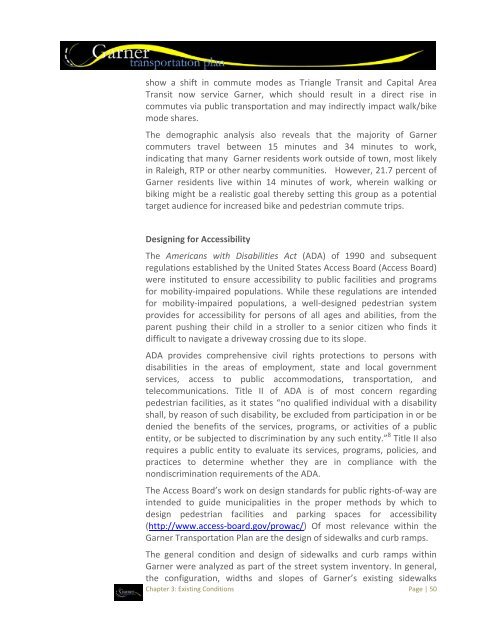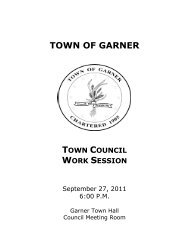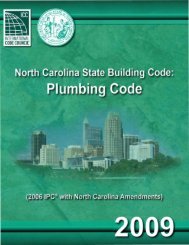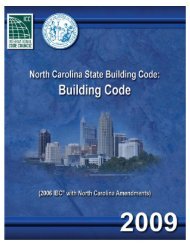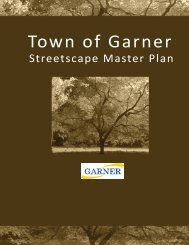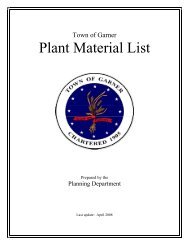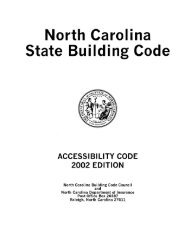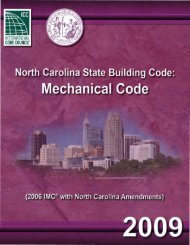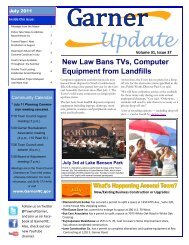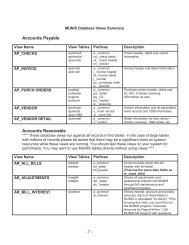Transportation Plan - Town of Garner
Transportation Plan - Town of Garner
Transportation Plan - Town of Garner
Create successful ePaper yourself
Turn your PDF publications into a flip-book with our unique Google optimized e-Paper software.
show a shift in commute modes as Triangle Transit and Capital Area<br />
Transit now service <strong>Garner</strong>, which should result in a direct rise in<br />
commutes via public transportation and may indirectly impact walk/bike<br />
mode shares.<br />
The demographic analysis also reveals that the majority <strong>of</strong> <strong>Garner</strong><br />
commuters travel between 15 minutes and 34 minutes to work,<br />
indicating that many <strong>Garner</strong> residents work outside <strong>of</strong> town, most likely<br />
in Raleigh, RTP or other nearby communities. However, 21.7 percent <strong>of</strong><br />
<strong>Garner</strong> residents live within 14 minutes <strong>of</strong> work, wherein walking or<br />
biking might be a realistic goal thereby setting this group as a potential<br />
target audience for increased bike and pedestrian commute trips.<br />
Designing for Accessibility<br />
The Americans with Disabilities Act (ADA) <strong>of</strong> 1990 and subsequent<br />
regulations established by the United States Access Board (Access Board)<br />
were instituted to ensure accessibility to public facilities and programs<br />
for mobility‐impaired populations. While these regulations are intended<br />
for mobility‐impaired populations, a well‐designed pedestrian system<br />
provides for accessibility for persons <strong>of</strong> all ages and abilities, from the<br />
parent pushing their child in a stroller to a senior citizen who finds it<br />
difficult to navigate a driveway crossing due to its slope.<br />
ADA provides comprehensive civil rights protections to persons with<br />
disabilities in the areas <strong>of</strong> employment, state and local government<br />
services, access to public accommodations, transportation, and<br />
telecommunications. Title II <strong>of</strong> ADA is <strong>of</strong> most concern regarding<br />
pedestrian facilities, as it states “no qualified individual with a disability<br />
shall, by reason <strong>of</strong> such disability, be excluded from participation in or be<br />
denied the benefits <strong>of</strong> the services, programs, or activities <strong>of</strong> a public<br />
entity, or be subjected to discrimination by any such entity.” 8 Title II also<br />
requires a public entity to evaluate its services, programs, policies, and<br />
practices to determine whether they are in compliance with the<br />
nondiscrimination requirements <strong>of</strong> the ADA.<br />
The Access Board’s work on design standards for public rights‐<strong>of</strong>‐way are<br />
intended to guide municipalities in the proper methods by which to<br />
design pedestrian facilities and parking spaces for accessibility<br />
(http://www.access‐board.gov/prowac/) Of most relevance within the<br />
<strong>Garner</strong> <strong>Transportation</strong> <strong>Plan</strong> are the design <strong>of</strong> sidewalks and curb ramps.<br />
The general condition and design <strong>of</strong> sidewalks and curb ramps within<br />
<strong>Garner</strong> were analyzed as part <strong>of</strong> the street system inventory. In general,<br />
the configuration, widths and slopes <strong>of</strong> <strong>Garner</strong>’s existing sidewalks<br />
Chapter 3: Existing Conditions Page | 50


